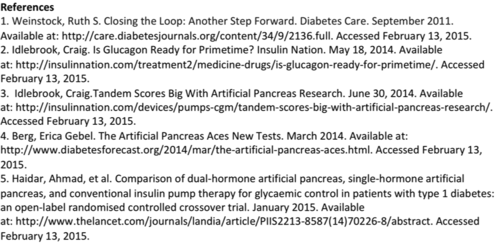Sage is here to help.
Feel like you could be eating better? Not sure what to change or where to look? Sage Nutritious Solutions make it easy for you to discover the wide, wonderful world of balanced, healthy, bangin' food.
Type 1 Diabetes & The Artificial Pancreas
In those without Type-1 Diabetes, insulin regulates blood sugar by allowing cells in the body to turn the sugar in the blood stream into energy. In those living with this kind of diabetes, the cells in the pancreas that produce insulin and other blood sugar-regulating hormones are destroyed by the immune system, so diabetics produce no insulin on their own. Additional abnormalities are often also present, including abnormal secretion and/or action of glucagon (1), the hormone produced to raise blood glucose levels when they drop too low. Although many diabetics suffer from high blood sugars, low blood sugar is also a concern as a result of the body’s inability to correct it on its own. Low blood sugar can result in confusion, disorientation, seizures, coma, and even death. Normal blood sugars range between 70-120, although deviations from this are usually allowed (120-180) due to the increased likelihood of high blood sugars.
Glucagon is used as an injection to correct these dangerously low blood sugars in those living with type-1 diabetes, especially when the person is unable to swallow juice or other food to bring the blood sugar back up. It is typically stored in powder form, which is then mixed with water immediately before injection. Once it is dissolved in water, it rapidly breaks down and becomes ineffective - so it cannot be stored premixed. Recent research by pharmaceutical company Xeris, though, has created a shelf-stable liquid glucagon (2).
Research in treatment of type-1 diabetes is advancing quickly and treatment methods are easier and more adaptable than ever before. Many diabetics manage their blood sugar by using an insulin pump about the size of a pager in addition to a glucometer, which measures blood sugar levels at that moment in time. The pump uses a small needle that slides under the skin into fatty tissue. It provides consistent small doses of insulin throughout the day, with additional short bursts of insulin made to cover meals and to treat high blood sugar. The development generating the most excitement is around new "pump" technology known as the dual-hormone artificial pancreas. This new technology will be able to provide both insulin and a second hormone, potentially the recently-developed shelf-stable glucagon, though other hormones could also be used (3).
The new artificial pancreas also closes the loop between glucometer use and the pump itself. Instead of the person checking their blood sugar, calculating the insulin and/or glucagon dosages, and dosing appropriately, a computer program calculates dosages based on readings from a sensor that continuously monitors blood sugar levels and automatically injects the right hormone at the right time.
Three recent studies have allowed patients to venture outside the confines of the clinic while testing the artificial pancreas, with researchers still closely monitoring the patients and technology (4). Though little has been published, preliminary findings of these insulin-only artificial pancreas studies look promising. So far, clinical trials of the dual-hormone artificial pancreas have also shown encouraging results, with patients’ blood sugars in the target range (70-120) 12% more frequently than using the traditional insulin pump (5). However, additional research is still needed. Whether patients will be able to maintain control in their day-to-day lives remains to be seen. Needless to say, this is an exciting time to be someone who lives with type-1 diabetes.

Happy Eating!
